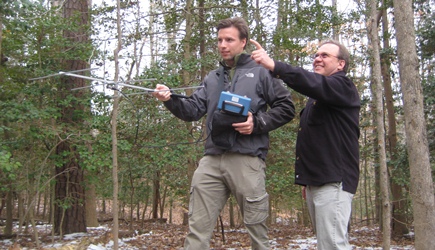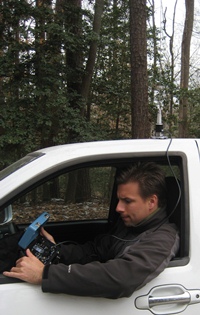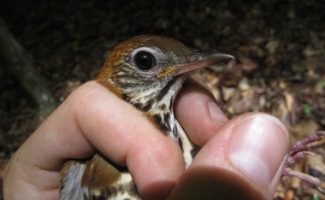Bird Detection 101: The Trials and Tribulations of Telemetry
 Last summer, graduate student Vitek Jirinec had his hands full of “bird-detection” gear, but the birds were not cooperating. Based on prior work in the Applied Conservation and Research Lab of Dr. Matthias Leu, Vitek knew that the Wood Thrush, a charismatic but declining species of bird known for its flute-like song, seemed to occur in highest abundance in forest patches embedded in a landscape dominated by low-density housing. This habitat association with human housing contradicted previous research indicating that thrushes required large, contiguous forest patches. To resolve the habitat preference issue, Vitek was using radio telemetry to examine habitat use by male birds during the breeding season. Earlier in the year, he had used a thin string backpack to attach small radio transmitters to the backs of 20 male Wood Thrushes. By June, however, Vitek was distressed to report that seven of the 20 males had disappeared from the territories where they were initially captured. Because transmitter signals cannot be detected more than 350 m from a tagged bird, he knew the birds had to be farther away than that, but in what direction? Relocating any of the missing males would be like finding a needle in a haystack.
Last summer, graduate student Vitek Jirinec had his hands full of “bird-detection” gear, but the birds were not cooperating. Based on prior work in the Applied Conservation and Research Lab of Dr. Matthias Leu, Vitek knew that the Wood Thrush, a charismatic but declining species of bird known for its flute-like song, seemed to occur in highest abundance in forest patches embedded in a landscape dominated by low-density housing. This habitat association with human housing contradicted previous research indicating that thrushes required large, contiguous forest patches. To resolve the habitat preference issue, Vitek was using radio telemetry to examine habitat use by male birds during the breeding season. Earlier in the year, he had used a thin string backpack to attach small radio transmitters to the backs of 20 male Wood Thrushes. By June, however, Vitek was distressed to report that seven of the 20 males had disappeared from the territories where they were initially captured. Because transmitter signals cannot be detected more than 350 m from a tagged bird, he knew the birds had to be farther away than that, but in what direction? Relocating any of the missing males would be like finding a needle in a haystack.
 Dr. Leu did his best to aid his graduate student: “After I bought Vitek a therapeutic coffee and some donuts to calm his nerves, we returned to an original capture location in Waller Mill Park with refreshed hopes that one of the missing males had returned to its territory. Alas, the bird was still missing.” The research pair then drove along residential roads skirting Waller Mill Park, listening fervently for signals from the missing birds at key vantage points. The sight of two biologists slowly cruising through residential neighborhoods—anxiously hanging out of their truck with antenna and receiver—was no doubt perplexing to many homeowners! Vitek noted: “We got a couple remarks to the effect ‘UFOs do not exist’ and ‘Did you hear back from them yet?’, and I think more than a few folks were fearful the tracking equipment was some kind of a weapon…”
Dr. Leu did his best to aid his graduate student: “After I bought Vitek a therapeutic coffee and some donuts to calm his nerves, we returned to an original capture location in Waller Mill Park with refreshed hopes that one of the missing males had returned to its territory. Alas, the bird was still missing.” The research pair then drove along residential roads skirting Waller Mill Park, listening fervently for signals from the missing birds at key vantage points. The sight of two biologists slowly cruising through residential neighborhoods—anxiously hanging out of their truck with antenna and receiver—was no doubt perplexing to many homeowners! Vitek noted: “We got a couple remarks to the effect ‘UFOs do not exist’ and ‘Did you hear back from them yet?’, and I think more than a few folks were fearful the tracking equipment was some kind of a weapon…”
The two searched for hours, driving until they reached the dead end of Camp Peary’s fence line. Jokingly, Dr. Leu suggested that it was time to employ heavy-duty bolt-cutters, but the weak attempt at humor couldn’t break their despondent mood. Beaten, they headed dismally back to William and Mary, conceding that the search was over. Still, they just couldn’t turn the receiver off, even though they looked like a sputnik satellite with an antenna affixed to the roof of the truck, traveling over 45 mph down Merrimac Trail. All of a sudden, Dr. Leu heard a suspicious beep on the receiver. “Vitek and I looked at each other wide-eyed and yelled: ‘was that a signal?’ Given our excitement and high speed, we overshot the first obvious vantage point, but wheeled around at the next one like police officers in hot pursuit of a criminal.”
They heard the suspicious beep again on a second drive-by, and now dared to hope they were on to something. They parked the truck, grabbed a more sensitive hand-held antenna, and raced back to the vantage point on foot. Now the signal was strong and not only could they identify the missing male, but they could roughly estimate where he had established his new territory, almost 10 times the detection distance from his original territory! One has to wonder: Was it dumb luck or skill?

Now that he is using the aptly named “sputnik method”, perhaps Vitek should change his name to Hi-tech, as he has found all seven of the missing birds. He’s collected enough data to document dispersal distances and show that male Wood Thrushes do indeed use forest habitat embedded in a landscape dominated by low-density housing. As Dr. Leu notes, “Hopefully, Vitek’s research can be implemented in urban planning to ensure that we always hear the melodious song of the Wood Thrush.”















